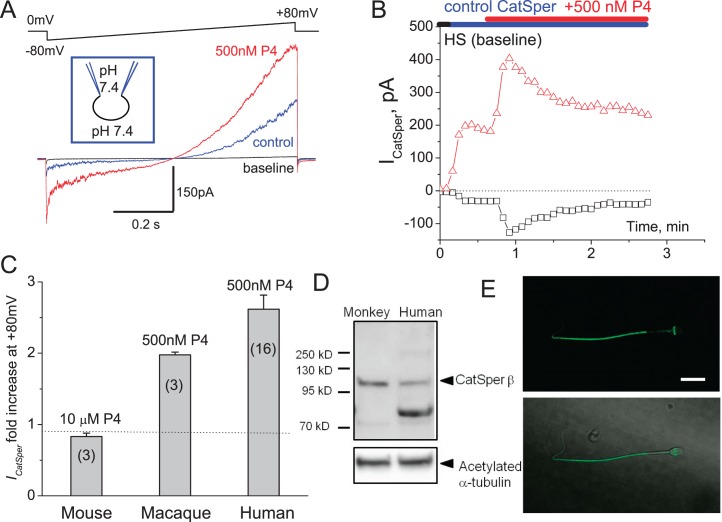FIG. 6.
CatSper channel is present in macaque sperm and is progesterone sensitive. A) CatSper currents (ICatSper) recorded from macaque spermatozoon in response to an indicated voltage ramp. Representative monovalent whole-cell ICatSper in the absence (blue) and presence (red) of 500 nM progesterone (P4). Currents were elicited by voltage ramps from a holding potential of 0 mV. Ramps were applied from −80 to +80 mV. The bath solution (DVF) contained 140 mM CsMeSO3, 1 mM EDTA, and 40 mM Hepes, pH adjusted with CsOH to 7.4. Pipettes were filled with 130 mM CsMeSO3, 60 mM Hepes, 1 mM EDTA, and 5 mM EGTA, pH 7.4. Shown are representative data out of three similar recordings; three different macaque spermatozoa were tested. B) Time dependence of primate ICatSper sensitivity to P4. Baseline (no CatSper activity) was recorded in HS solution, after which it was substituted with DVF solution as mentioned above; 500 nM P4 were added in DVF solution. C) Comparison between sensitivity of human, mouse, and primate CatSpers to indicated concentrations of P4; n = indicates number of sperm cells tested. D) Western blot of primate and human isolated spermatozoa shows CatSperβ subunit being expressed in sperm of both species. Acetylated tubulin was used as loading control. E) CatSper immunocytochemistry staining. Anti-CatSper4 antibody (Alomone labs; 1:100 dilution) recognize principal piece of monkey sperm. Upper panel shows immunofluorescent signal for CatSper4 from monkey spermatozoon, while the lower panel shows DIC image of the same cell overlaid with the immunofluorescent signal shown above.

